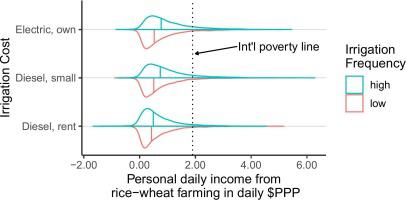Agricultural Systems ( IF 6.6 ) Pub Date : 2023-02-24 , DOI: 10.1016/j.agsy.2023.103618 Anton Urfels 1, 2, 3 , Kai Mausch 4 , Dave Harris 5, 6 , Andrew J McDonald 7 , Avinash Kishore 8 , Balwinder-Singh 9, 10 , Gerardo van Halsema 2 , Paul C Struik 3 , Peter Craufurd 1 , Timothy Foster 11 , Vartika Singh 8 , Timothy J Krupnik 12

|
CONTEXT
Millions of people living in the Eastern Gangetic Plains (EGP) of India engage in agriculture to support their livelihoods yet are income poor, and food and climate insecure. To address these challenges, policymakers and development programs invest in irrigation-led agricultural intensification. However, the evidence for agricultural intensification to lift farmers' incomes above the poverty line remains largely anecdotal.
OBJECTIVE
The main objective of this study is to use a large household survey (n = 15,572; rice: 8244, wheat: 7328; 2017/18) to assess the link between agricultural intensification and personal daily incomes from farming (FPDI) in the rice-wheat systems of the EGP – the dominant cropping system of the region.
METHODS
We use the Intensification Benefit Index (IBI), a measure that relates farm size and household size to FPDI, to assess how daily incomes from rice-wheat production change with irrigation-led intensification across the EGP.
RESULTS AND CONCLUSIONS
Relative to the international poverty line of 1.90 Purchasing Power Parity (PPP)$ day−1 and accounting for variations in HH size in the analysis, we found that small farm sizes limit the potential for agricultural intensification from irrigation to transform the poverty status of households in the bottom three quartiles of the IBI. The estimated median FPDI of households with intensified systems in the bottom three quartiles is only 0.51 PPP$ day−1 (a 0.15 PPP$ gain). The median FPDI increases to 2.10 PPP$ day−1 for households in the upper quartile of the IBI distribution (a 0.30 PPP$ gain). Irrigation-led agricultural intensification of rice-wheat systems in the EGP may provide substantial benefits for resilience to climatic change and food security but achieving meaningful poverty reduction will require complementary investments.
SIGNIFICANCE
Transforming the poverty status of most smallholder farmers in the EGP requires diversified portfolios of rural on- and off-farm income-generating opportunities. While bolstering food- and climate security, agronomic intervention programs should consider smallholders' limited monetary incentives to invest in intensification. Irrigation-led agricultural intensification programs and policies should explicitly account for the heterogeneity in household resources, irrigation levels, and degree of dependence on agricultural income.
中文翻译:

即使以灌溉为主导的集约化,农场规模也限制了印度东部农业的减贫潜力
语境
生活在印度东部恒河平原 (EGP) 的数百万人从事农业以维持生计,但收入微薄,粮食和气候不安全。为了应对这些挑战,政策制定者和发展计划投资于以灌溉为主导的农业集约化。然而,农业集约化将农民收入提高到贫困线以上的证据在很大程度上仍然是传闻。
客观的
本研究的主要目的是使用大型家庭调查(n = 15,572;水稻:8244,小麦:7328;2017/18)评估农业集约化与个人农业日收入(FPDI)之间的联系。 EGP 的小麦系统——该地区的主要种植系统。
方法
我们使用集约化效益指数 (IBI),这是一种将农场规模和家庭规模与 FPDI 联系起来的衡量标准,以评估稻麦生产的每日收入如何随着 EGP 灌溉主导的集约化而变化。
结果和结论
相对于 1.90 购买力平价 (PPP)$ day −1的国际贫困线并在分析中考虑 HH 规模的变化,我们发现小型农场限制了通过灌溉实现农业集约化以改变家庭贫困状况的潜力在 IBI 的底部三个四分位数中。后四分位数中采用强化系统的家庭的 FPDI 中位数估计仅为 0.51 PPP$ day −1(0.15 PPP$ 收益)。FPDI 中位数增加到 2.10 PPP$ 天-1对于 IBI 分布上四分位数的家庭(0.30 PPP$ 收益)。EGP 中以灌溉为主导的稻麦系统农业集约化可能会为气候变化和粮食安全的恢复力带来巨大好处,但实现有意义的减贫将需要补充投资。
意义
改变 EGP 中大多数小农的贫困状况需要多样化的农村内外创收机会组合。在加强粮食和气候安全的同时,农艺干预计划应考虑小农对集约化投资的有限货币激励。以灌溉为主导的农业集约化计划和政策应明确考虑家庭资源、灌溉水平和对农业收入的依赖程度的异质性。



























 京公网安备 11010802027423号
京公网安备 11010802027423号